Page 343 of 587

▫Carbon Monoxide Warnings ............ 428
� Flexible Fuel (3.6L Engine Only) —
If Equipped .......................... 429
▫ E-85 General Information ............... 429
▫ Ethanol Fuel (E-85) ................... 430
▫ Fuel Requirements ................... 430
▫ Selection Of Engine Oil For Flexible Fuel
Vehicles (E-85) And Gasoline Vehicles ...... 431
▫ Starting ........................... 432
▫ Cruising Range ...................... 432
▫ Replacement Parts ................... 432
▫ Maintenance ........................ 432 �
Adding Fuel ......................... 433
▫ Fuel Filler Cap (Gas Cap) .............. 433
▫ Loose Fuel Filler Cap Message ........... 436
� Vehicle Loading ...................... 436
▫ Certification Label ................... 436
� Trailer Towing ........................ 438
▫ Common Towing Definitions ............ 439
▫ Trailer Hitch Classification .............. 443
▫ Trailer Towing Weights
(Maximum Trailer Weight Ratings) ........ 444
▫ Trailer And Tongue Weight ............. 445
▫ Towing Requirements ................. 446
▫ Towing Tips ........................ 451
5
STARTING AND OPERATING 341
Page 345 of 587
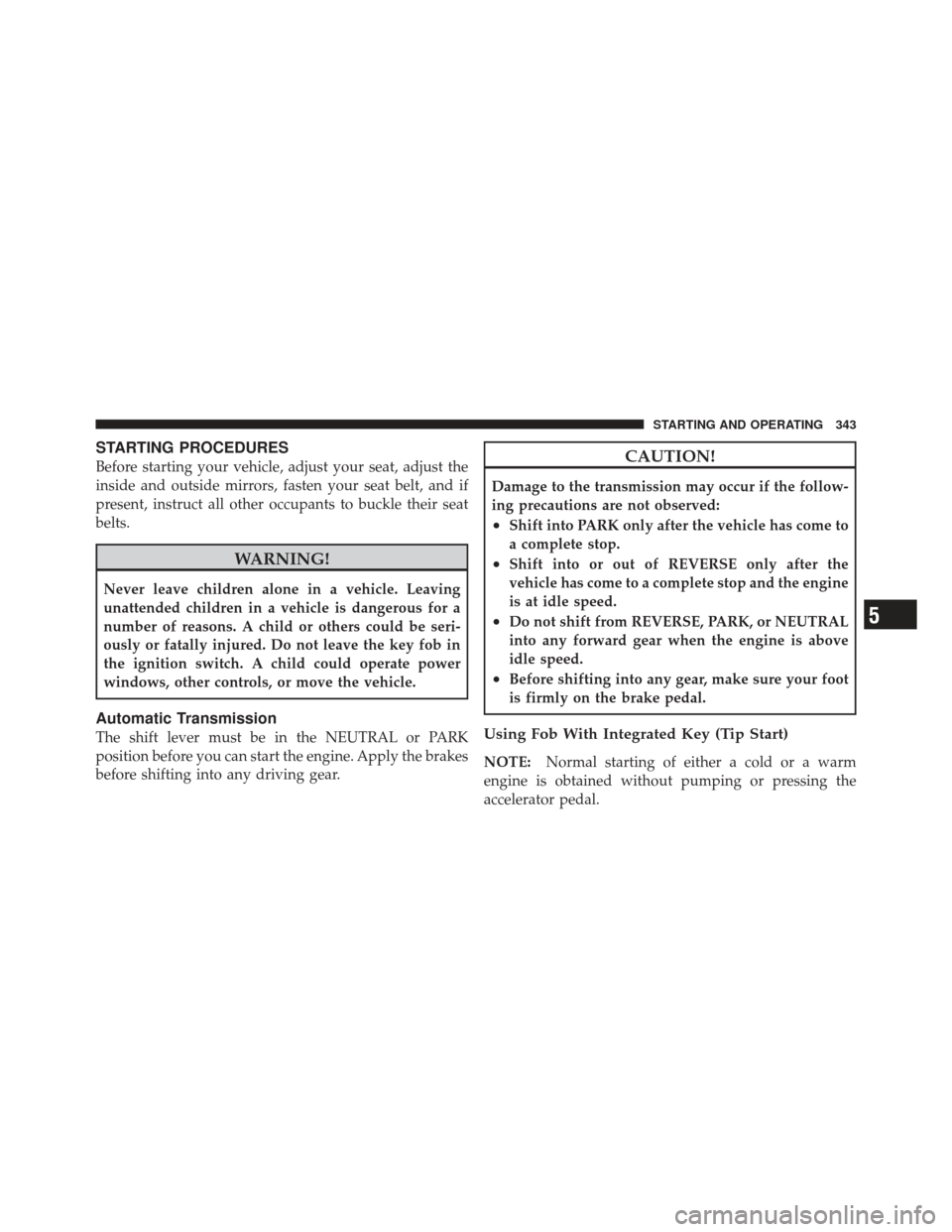
STARTING PROCEDURES
Before starting your vehicle, adjust your seat, adjust the
inside and outside mirrors, fasten your seat belt, and if
present, instruct all other occupants to buckle their seat
belts.
WARNING!
Never leave children alone in a vehicle. Leaving
unattended children in a vehicle is dangerous for a
number of reasons. A child or others could be seri-
ously or fatally injured. Do not leave the key fob in
the ignition switch. A child could operate power
windows, other controls, or move the vehicle.
Automatic Transmission
The shift lever must be in the NEUTRAL or PARK
position before you can start the engine. Apply the brakes
before shifting into any driving gear.
CAUTION!
Damage to the transmission may occur if the follow-
ing precautions are not observed:
•Shift into PARK only after the vehicle has come to
a complete stop.
•Shift into or out of REVERSE only after the
vehicle has come to a complete stop and the engine
is at idle speed.
•Do not shift from REVERSE, PARK, or NEUTRAL
into any forward gear when the engine is above
idle speed.
•Before shifting into any gear, make sure your foot
is firmly on the brake pedal.
Using Fob With Integrated Key (Tip Start)
NOTE:Normal starting of either a cold or a warm
engine is obtained without pumping or pressing the
accelerator pedal.
5
STARTING AND OPERATING 343
Page 349 of 587
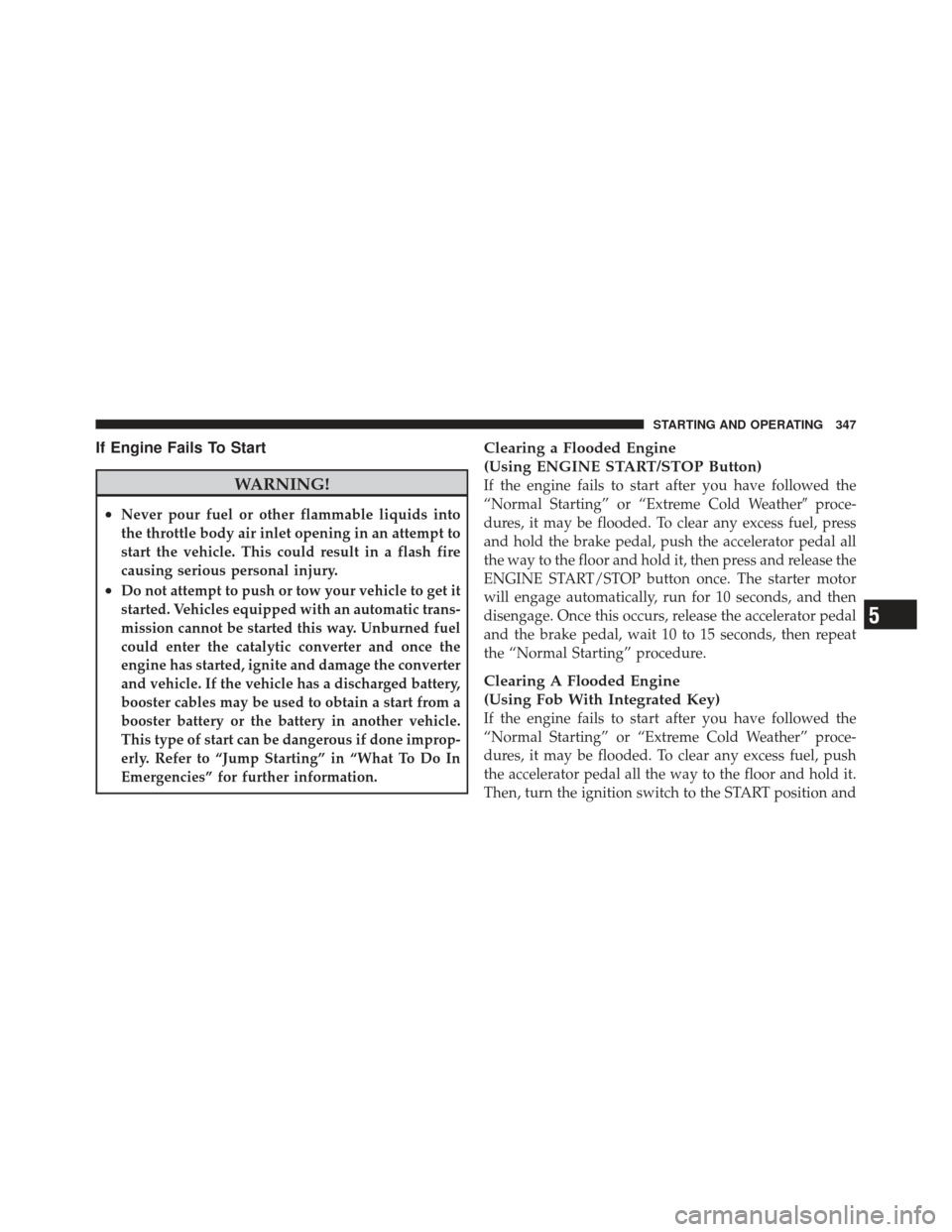
If Engine Fails To Start
WARNING!
•Never pour fuel or other flammable liquids into
the throttle body air inlet opening in an attempt to
start the vehicle. This could result in a flash fire
causing serious personal injury.
•Do not attempt to push or tow your vehicle to get it
started. Vehicles equipped with an automatic trans-
mission cannot be started this way. Unburned fuel
could enter the catalytic converter and once the
engine has started, ignite and damage the converter
and vehicle. If the vehicle has a discharged battery,
booster cables may be used to obtain a start from a
booster battery or the battery in another vehicle.
This type of start can be dangerous if done improp-
erly. Refer to “Jump Starting” in “What To Do In
Emergencies” for further information.
Clearing a Flooded Engine
(Using ENGINE START/STOP Button)
If the engine fails to start after you have followed the
“Normal Starting” or “Extreme Cold Weather�proce-
dures, it may be flooded. To clear any excess fuel, press
and hold the brake pedal, push the accelerator pedal all
the way to the floor and hold it, then press and release the
ENGINE START/STOP button once. The starter motor
will engage automatically, run for 10 seconds, and then
disengage. Once this occurs, release the accelerator pedal
and the brake pedal, wait 10 to 15 seconds, then repeat
the “Normal Starting” procedure.
Clearing A Flooded Engine
(Using Fob With Integrated Key)
If the engine fails to start after you have followed the
“Normal Starting” or “Extreme Cold Weather” proce-
dures, it may be flooded. To clear any excess fuel, push
the accelerator pedal all the way to the floor and hold it.
Then, turn the ignition switch to the START position and
5
STARTING AND OPERATING 347
Page 350 of 587
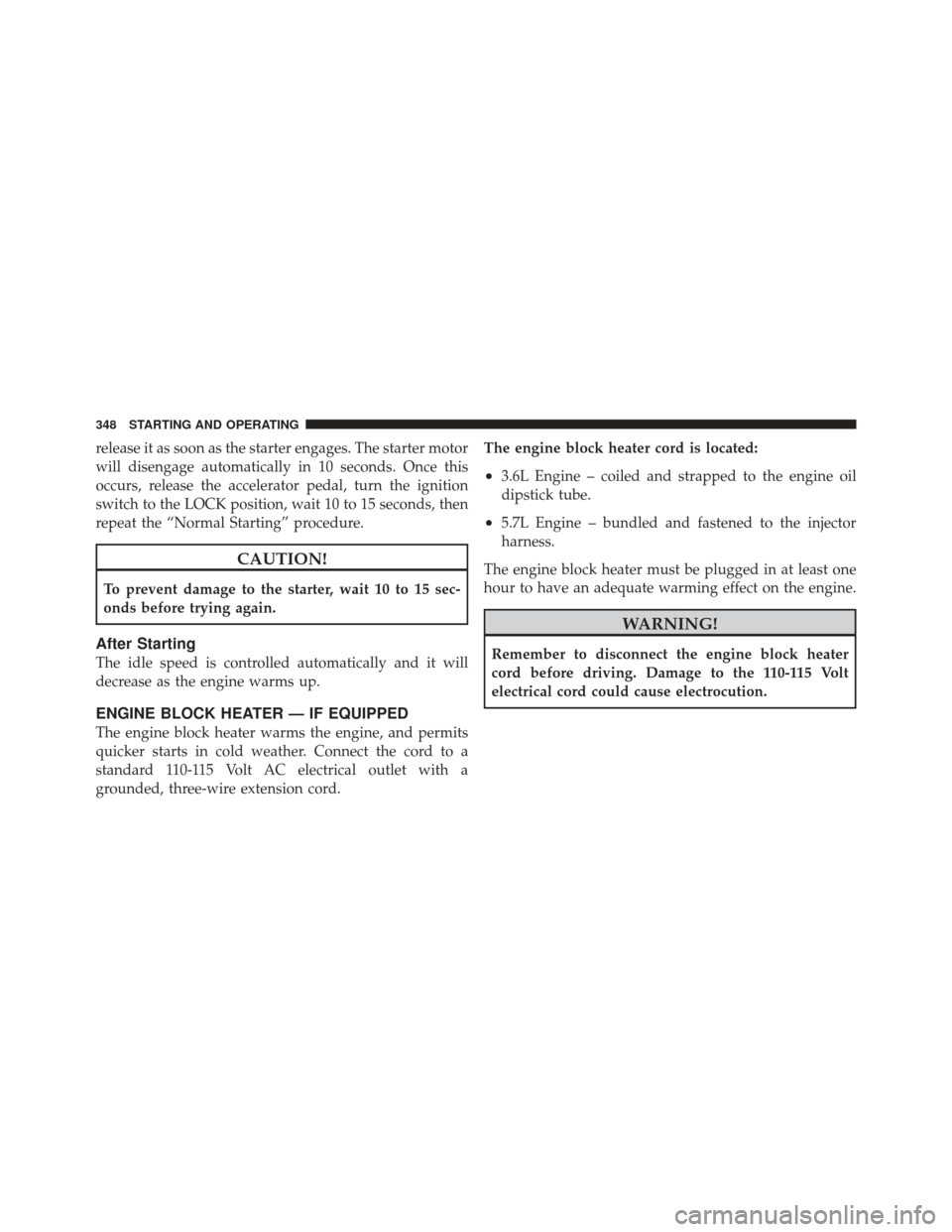
release it as soon as the starter engages. The starter motor
will disengage automatically in 10 seconds. Once this
occurs, release the accelerator pedal, turn the ignition
switch to the LOCK position, wait 10 to 15 seconds, then
repeat the “Normal Starting” procedure.
CAUTION!
To prevent damage to the starter, wait 10 to 15 sec-
onds before trying again.
After Starting
The idle speed is controlled automatically and it will
decrease as the engine warms up.
ENGINE BLOCK HEATER — IF EQUIPPED
The engine block heater warms the engine, and permits
quicker starts in cold weather. Connect the cord to a
standard 110-115 Volt AC electrical outlet with a
grounded, three-wire extension cord.The engine block heater cord is located:
•3.6L Engine – coiled and strapped to the engine oil
dipstick tube.
•5.7L Engine – bundled and fastened to the injector
harness.
The engine block heater must be plugged in at least one
hour to have an adequate warming effect on the engine.
WARNING!
Remember to disconnect the engine block heater
cord before driving. Damage to the 110-115 Volt
electrical cord could cause electrocution.
348 STARTING AND OPERATING
Page 351 of 587
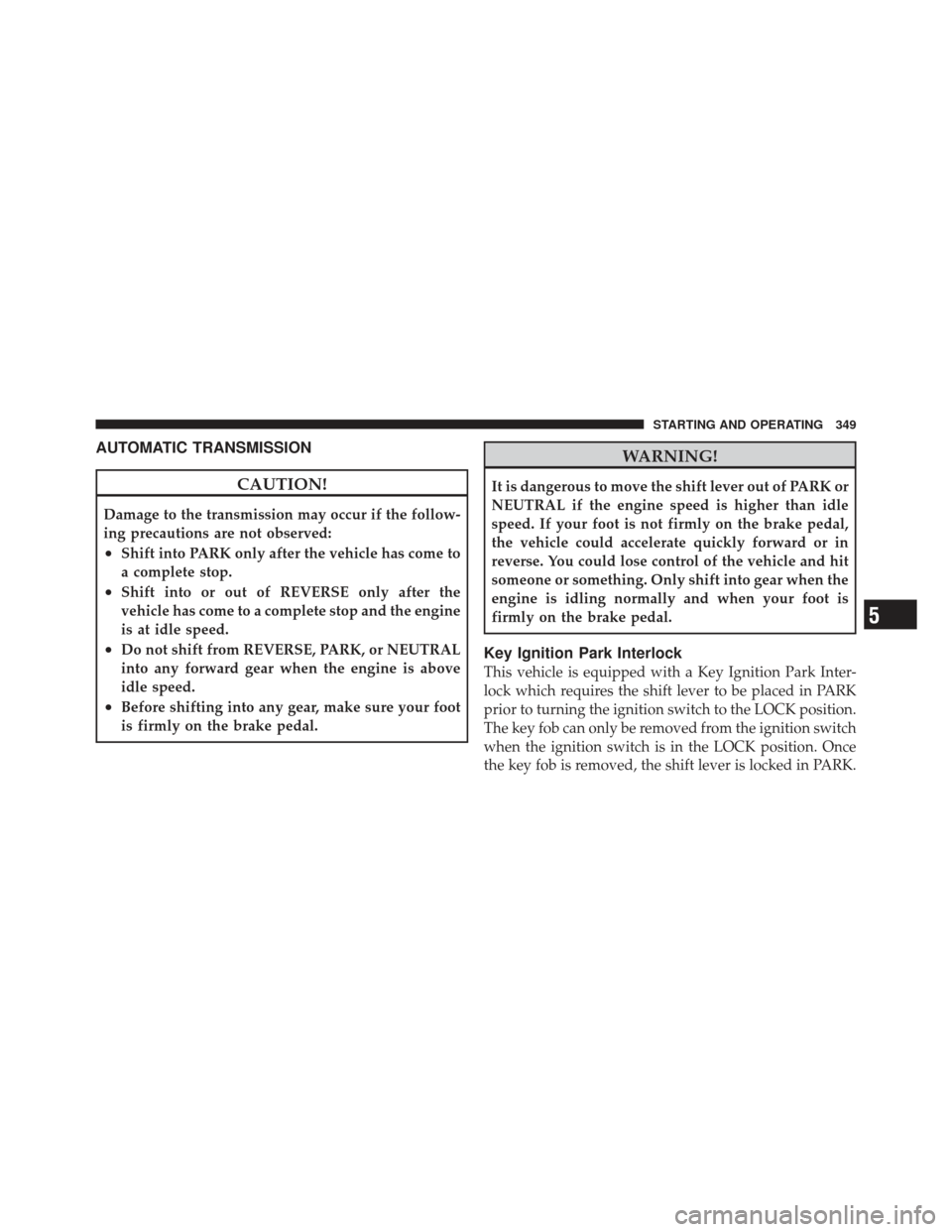
AUTOMATIC TRANSMISSION
CAUTION!
Damage to the transmission may occur if the follow-
ing precautions are not observed:
•Shift into PARK only after the vehicle has come to
a complete stop.
•Shift into or out of REVERSE only after the
vehicle has come to a complete stop and the engine
is at idle speed.
•Do not shift from REVERSE, PARK, or NEUTRAL
into any forward gear when the engine is above
idle speed.
•Before shifting into any gear, make sure your foot
is firmly on the brake pedal.
WARNING!
It is dangerous to move the shift lever out of PARK or
NEUTRAL if the engine speed is higher than idle
speed. If your foot is not firmly on the brake pedal,
the vehicle could accelerate quickly forward or in
reverse. You could lose control of the vehicle and hit
someone or something. Only shift into gear when the
engine is idling normally and when your foot is
firmly on the brake pedal.
Key Ignition Park Interlock
This vehicle is equipped with a Key Ignition Park Inter-
lock which requires the shift lever to be placed in PARK
prior to turning the ignition switch to the LOCK position.
The key fob can only be removed from the ignition switch
when the ignition switch is in the LOCK position. Once
the key fob is removed, the shift lever is locked in PARK.
5
STARTING AND OPERATING 349
Page 353 of 587
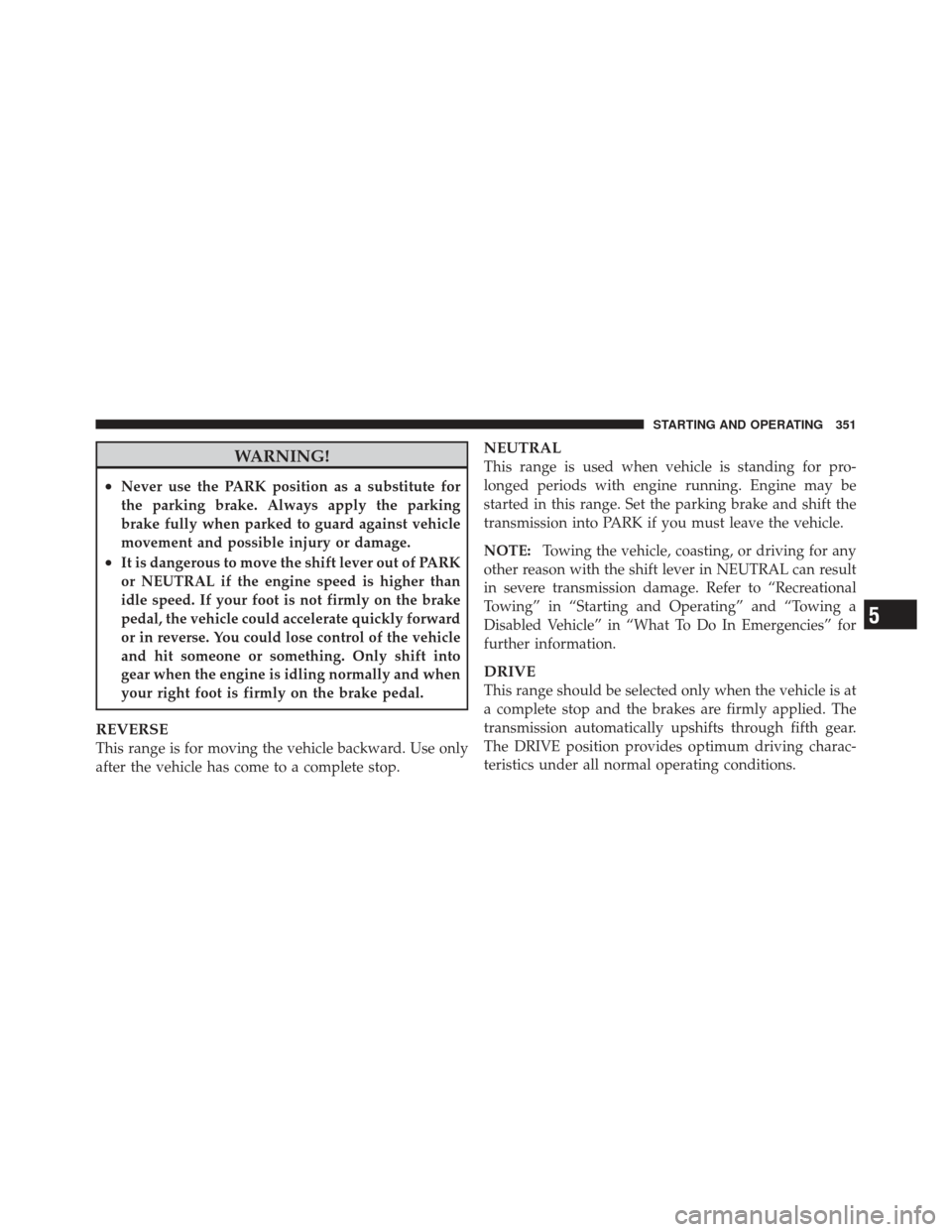
WARNING!
•Never use the PARK position as a substitute for
the parking brake. Always apply the parking
brake fully when parked to guard against vehicle
movement and possible injury or damage.
•It is dangerous to move the shift lever out of PARK
or NEUTRAL if the engine speed is higher than
idle speed. If your foot is not firmly on the brake
pedal, the vehicle could accelerate quickly forward
or in reverse. You could lose control of the vehicle
and hit someone or something. Only shift into
gear when the engine is idling normally and when
your right foot is firmly on the brake pedal.
REVERSE
This range is for moving the vehicle backward. Use only
after the vehicle has come to a complete stop.
NEUTRAL
This range is used when vehicle is standing for pro-
longed periods with engine running. Engine may be
started in this range. Set the parking brake and shift the
transmission into PARK if you must leave the vehicle.
NOTE:Towing the vehicle, coasting, or driving for any
other reason with the shift lever in NEUTRAL can result
in severe transmission damage. Refer to “Recreational
Towing” in “Starting and Operating” and “Towing a
Disabled Vehicle” in “What To Do In Emergencies” for
further information.
DRIVE
This range should be selected only when the vehicle is at
a complete stop and the brakes are firmly applied. The
transmission automatically upshifts through fifth gear.
The DRIVE position provides optimum driving charac-
teristics under all normal operating conditions.
5
STARTING AND OPERATING 351
Page 355 of 587
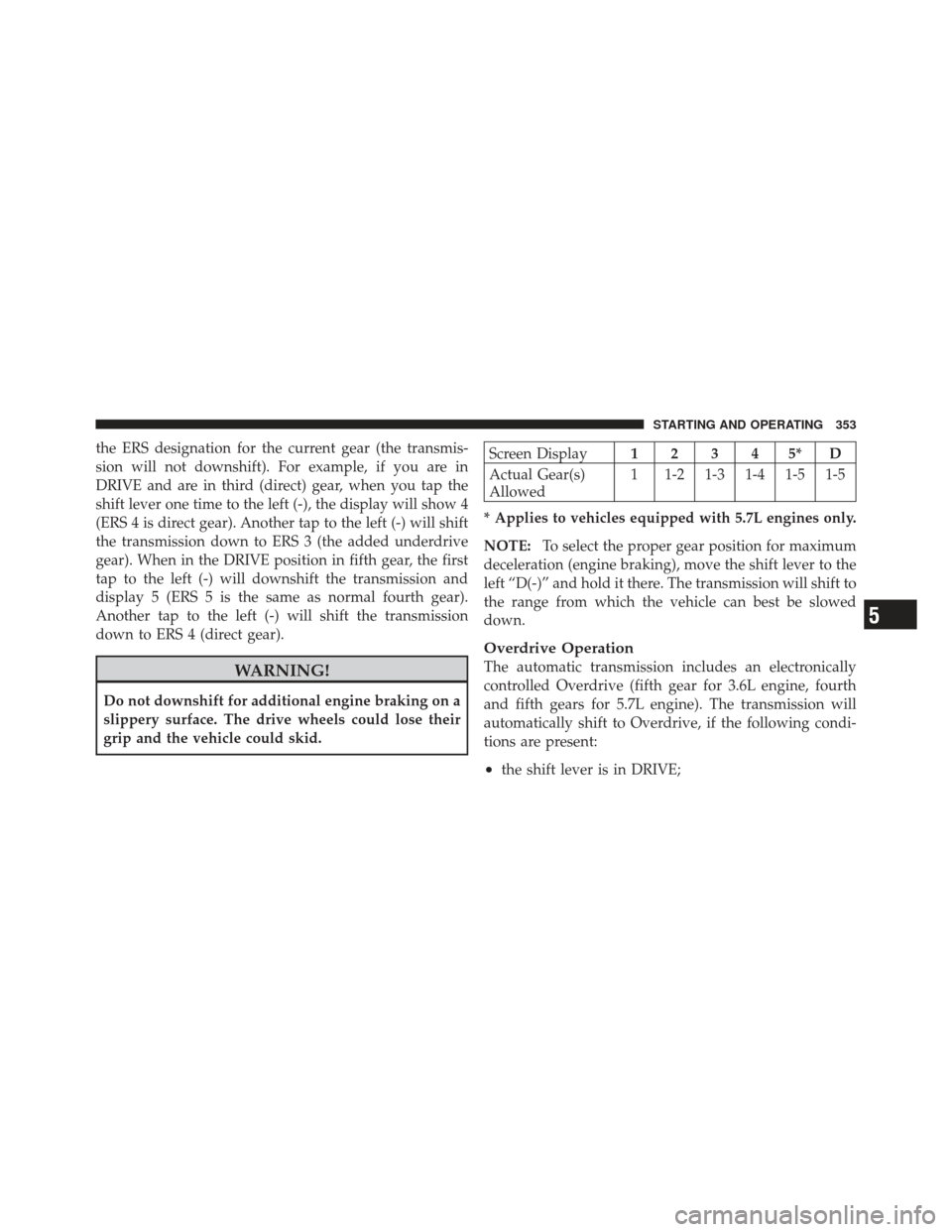
the ERS designation for the current gear (the transmis-
sion will not downshift). For example, if you are in
DRIVE and are in third (direct) gear, when you tap the
shift lever one time to the left (-), the display will show 4
(ERS 4 is direct gear). Another tap to the left (-) will shift
the transmission down to ERS 3 (the added underdrive
gear). When in the DRIVE position in fifth gear, the first
tap to the left (-) will downshift the transmission and
display 5 (ERS 5 is the same as normal fourth gear).
Another tap to the left (-) will shift the transmission
down to ERS 4 (direct gear).
WARNING!
Do not downshift for additional engine braking on a
slippery surface. The drive wheels could lose their
grip and the vehicle could skid.
Screen Display12345*D
Actual Gear(s)
Allowed 1 1-2 1-3 1-4 1-5 1-5
* Applies to vehicles equipped with 5.7L engines only.
NOTE: To select the proper gear position for maximum
deceleration (engine braking), move the shift lever to the
left “D(-)” and hold it there. The transmission will shift to
the range from which the vehicle can best be slowed
down.
Overdrive Operation
The automatic transmission includes an electronically
controlled Overdrive (fifth gear for 3.6L engine, fourth
and fifth gears for 5.7L engine). The transmission will
automatically shift to Overdrive, if the following condi-
tions are present:
•the shift lever is in DRIVE;
5
STARTING AND OPERATING 353
Page 361 of 587
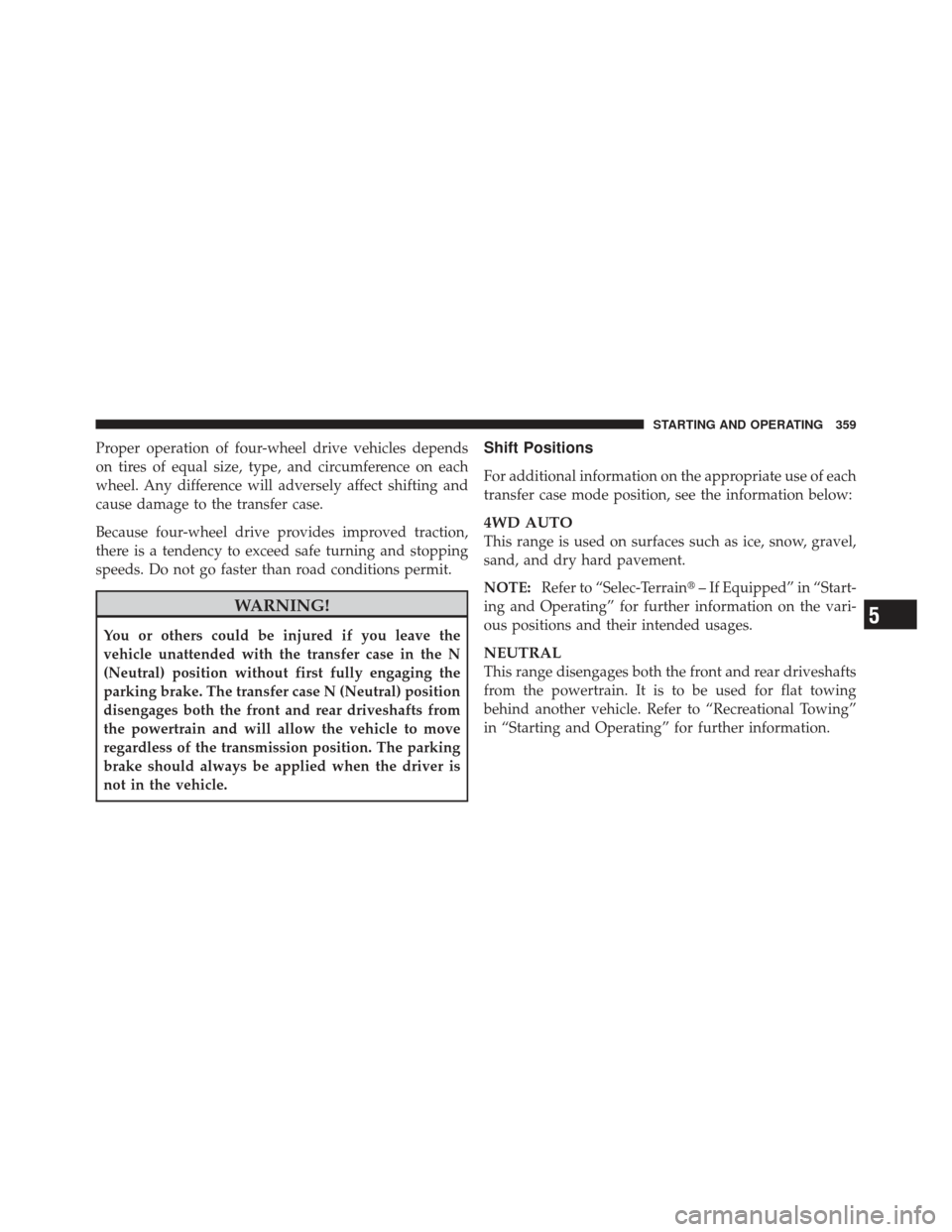
Proper operation of four-wheel drive vehicles depends
on tires of equal size, type, and circumference on each
wheel. Any difference will adversely affect shifting and
cause damage to the transfer case.
Because four-wheel drive provides improved traction,
there is a tendency to exceed safe turning and stopping
speeds. Do not go faster than road conditions permit.
WARNING!
You or others could be injured if you leave the
vehicle unattended with the transfer case in the N
(Neutral) position without first fully engaging the
parking brake. The transfer case N (Neutral) position
disengages both the front and rear driveshafts from
the powertrain and will allow the vehicle to move
regardless of the transmission position. The parking
brake should always be applied when the driver is
not in the vehicle.
Shift Positions
For additional information on the appropriate use of each
transfer case mode position, see the information below:
4WD AUTO
This range is used on surfaces such as ice, snow, gravel,
sand, and dry hard pavement.
NOTE:Refer to “Selec-Terrain� – If Equipped” in “Start-
ing and Operating” for further information on the vari-
ous positions and their intended usages.
NEUTRAL
This range disengages both the front and rear driveshafts
from the powertrain. It is to be used for flat towing
behind another vehicle. Refer to “Recreational Towing”
in “Starting and Operating” for further information.
5
STARTING AND OPERATING 359